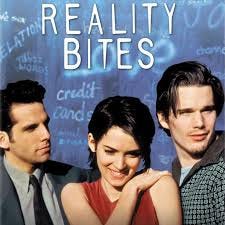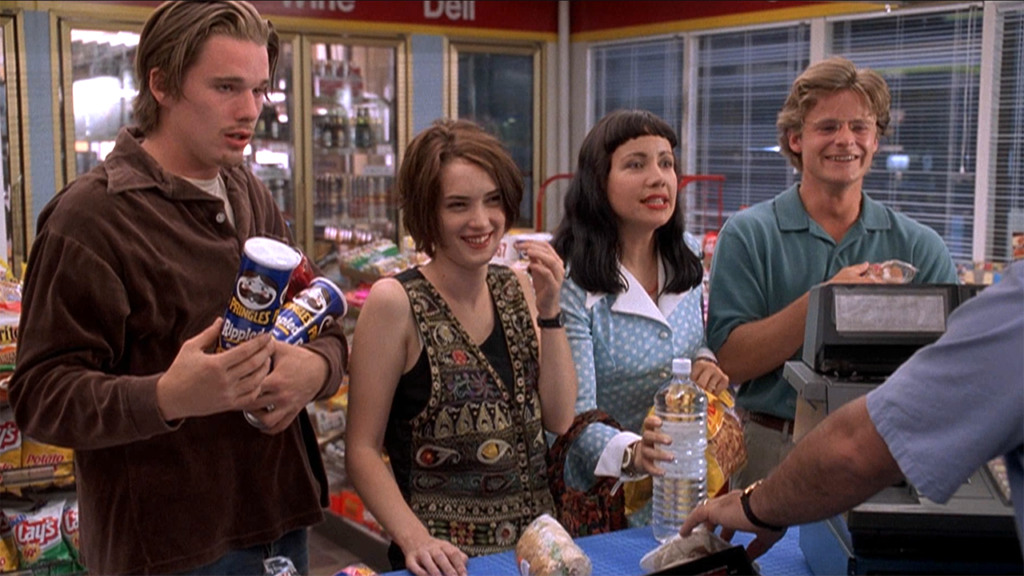Certain films can become so part of the culture and ubiquitous that you can convince yourself that you have seen it. In my case, that film was Reality Bites. Ben Stiller’s directorial debut aged 29, so effectively evokes the social mores and culture of the 90’s Gen-X scene that you can practically smell the pungent scent of patchouli oil and weed through the screen. From the opening drum beats of Rock and Roll part 2 by Gary Glitter (I know) and the hand-held images of Winona Ryder’s character Lelaina delivering her University graduation speech, it is 1994 again. It is sobering to think that the film celebrated its 30th anniversary this year.
The success of the film relies heavily on the chemistry between the four protagonists, which is beautifully captured on screen. Winona Ryder, Ethan Hawke, Steve Zahn and Janeane Garofalo have such an easy and natural rapport that the viewer can easily relate their repartee to their own set of university friends. In some ways they inhabit particular archetypal characters that we have all encountered in our lives. Hawke epitomises the rebel through a 90’s lens. This rebel is passive in his resistance, not conforming to societal expectations of starting a career, buying a house and getting married. He is intelligent and curious about philosophy but can be mean-spirited and spiteful. An asshole in some people’s books, young and deluded in others.
Lelaina documents her friend’s activities and conversations on a hand-held camera in the hope of creating a fly on the wall documentary on the trials and travails of 90’s twenty-somethings. Stiller weaves these sequences beautifully into the main narrative, hinting at the wider American lurch towards the reality TV genre in the form of MTV’s The Real World. The film itself received some criticism at the time for packaging the 90’s youth culture into what was essentially a commodity, from disaffection to confection if you will. However this theme is dealt with in the film to a degree that at worst, lets it off the hook and at best, ascribes a clever meta-narrative to proceedings.
The film’s beating heart is the tentative pairing of Troy (Hawke) and Lelaina (Ryder.) Troy knows what he wants but persists in doing everything to achieve the opposite. Ultimately though, some of the most memorable and enjoyable scenes involve all four. If one wanted to encapsulate Gen-X in one scene, it would have to be the convenience store scene. They are all stoned, buying snacks and dancing to the iconic song My Sharona by The Knack. Steve Zahn completely shines here as he watches Garofalo and Ryder dance in front of the shop clerk. His furtive smirk and then outright giggle followed by him joining in with the stoned dancing will lift me out of the deepest depression without fail every time. It has become iconic. Stiller shows his directorial chops by cutting to a beautiful exterior shot of the store at night, highly reminiscent of the great American artist Edward Hopper.
The analogue nature of life in the 90’s becomes all the more striking the further away in time we get. No mobile phones. No internet. Hand-held cameras are huge. It is often the case the older we get we pine for the time of our youth but the technological and societal shifts have been profound in the intervening years. The film is such a perfectly executed depiction of that time; it cuts that bit deeper for any viewer who lived through the 90’s. It is like crack cocaine to the nostalgia gland, making 40 and 50 somethings all misty eyed in the process. They were better times. They really were though. Weren’t they?
Vickie (Garofalo) is shown going for a HIV test and receiving the results in subsequent scenes. It is a stark reminder of the epidemic which ripped through firstly, the gay community, then the general public. Sammy (Zahn) spends time building up to coming out to his mother, an aspect of society which is now more heavily underpinned by acceptance and understanding. These aspects of the plot lend the film more weight and gravitas that deftly counterbalances the more whimsical scenes. Writer, Helen Childress, drew from her own experiences and friends at the time to create the screenplay, which went through over 70 drafts. The economic recession that hit America around this time proved to be fertile ground for Childress, who saw the plight of her peers as a story worth telling.
The success of the film was helped by a stellar soundtrack. If you listened to a radio for at least 5 minutes in 1994, you would have heard the massive hit Baby I Love Your Way by Big Mountain. Originally written by Peter Frampton, the video for the cover included excerpts from the film, which presented it as a traditional rom-com, not taking into account the grittier aspects of the film. Whatever the case, the film remains a classic thirty years later. It perfectly scratches that nostalgic itch we all get from time to time, that achy yearning for times gone past. It also reminds us of the importance of friends and the impact they leave on our lives. It reminds us of the bruises and scars we suffered through and how, in fact, these were the things that shaped us the most.






